Finding the middle way in high style at the Pint Shop in Cambridge, England.
1. Of town and splendid gown.
Cambridge has no dreaming spires of Oxford lore, no concentration of stone confectionary crowning its colleges. Neither, however, does Oxford itself except through the illusion conjured by telephoto telemetry. Cambridge is not, quite, as old either, and always appears second when the ancient English universities appear together, whether in print or through speech.
Aside from the attainments of their graduates, which taken en masse are indistinguishable and intimidating enough in terms of achievement, a number of other variations also set the schools and their towns apart. If the architecture of each university is a showcase for over eight centuries of outstanding design, time has been kinder to the city of Cambridge. Its center is barely pocked by modern mediocrity and it did not industrialize in the manner of Oxford.
2. Urbs in horto but not Chicago.
The city also enjoys considerably more greenspace at its core, parks and squares with suitably medieval names likes Christ’s Pieces (relics anyone?) and Jesus Green (named for the college, not its namesake).
Also unlike Oxford, where the university shrugs past the Cherwell and Isis for anything other than a passage for punting, a river, as they say, runs through Cambridge, and to spectacular effect. Colleges like Clare, Magdalene and St. John’s straddle the Cam, while the Backs, broad verges rising to the west of town, provide vistas not just of icons--not only the soaring chapel of King’s College, inescapable if informal symbol of the university itself and the adjacent Gibbs’ Building that Pevsner has called “by some distance the greatest collegiate building of Cambridge” but also of a great deal more.
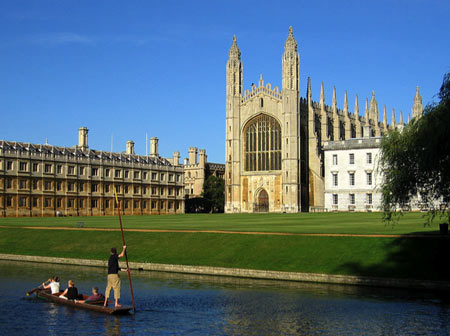 King’s College, Cambridge
King’s College, Cambridge
With few notable exceptions, at Christ Church in particular, the Oxford colleges lack the expansive spaces that many of their Cambridge counterparts enjoy. Those colleges decided to build around bigger courtyards, and many consist of quadrangles open at one end, urban squares that create the illusion of bleeding into country. The compositions are at once appealing in the compression that defines Oxford while also evoking an even more pronounced sensation of serenity.
Cambridge displays a greater variety of building materials than Oxford, where plenty of luminous stone lies within easy drag of the city. Its rival has needed to forage farther afield, so varieties of stone and expanses of brick unseen at Oxford proliferate there. This is both good and bad. The uniformity of Oxford stone is itself a sort of pleasing composition, while the eclectic surfaces of Cambridge provoke interest, even surprise and no little delight.
3. Jesus has it good.
Jesus College, one of the older and airier precincts of the urbane Cambridge campus (although in deference to the jealously maintained privilege intrinsic not only to the identity of each college but also to the university writ large, none in the know would call it something so centripedal as that), unfolds in a closed cloister and five of the characteristic open courts. Together they create a seamless composition in differing scales despite their architectural accretions in all the Cambridge iterations of brick and stone spanning more than half a millennium. The oldest complex at Jesus, a cloister and chapel built abaft the reredorter of its nuns, dates to the 1100s but scans the centuries to include restorations, recreations and reproductions as well as original painting, sculpture and furnishings sympathetic to its evolving cast by Pugin, Morris, Burne-Jones, Ford Madox Brown and other talents.
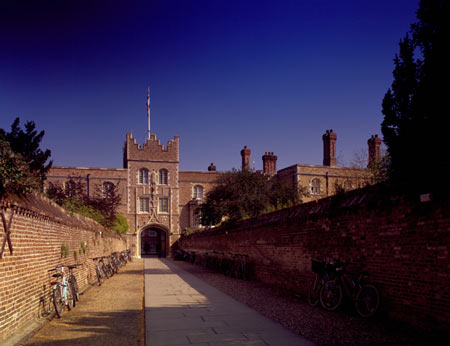
The Chimney, Jesus College
Then up went “the chimney,” in fact not a passage for smoke but instead portal to the First Court of the college, still standing since 1503, followed in turn by First Court in 1507, Second in 1822, Chapel Court in 1885, North Court in 1963 and a Neogothic Library Court completed in 2000.
4. But what about the food?
Perhaps we digress. britishfoodinamerica is, or maybe ought to be, about the food. Food, however, requires context, and context colors anybody’s perception of food. Humble pie, either apple or blueberry please, eaten with friends at a greasy spoon in the slough of a hangover at an inadvisable time of day, or night, or at least in deep darkness anyway, can make memories as powerful as places anointed by Michelin, Ronay, Zagat or any other arbiter.
Cambridge has its iconic places to go for comfort and incidentally for food. In particular Fitzbillies abides, rescued by Tim Hayward from the obsolescence of changing taste. Now it is nothing if not tasteful, an elegant ultraStarbucks independently owned that offers dependably good coffee, tea and cakes, and now serves ineffably British dinners during the span of the long college weekend beginning Thursday night. If it is not nearly so nurturing as Louis, the incubator of tortured talent celebrated in prose by more than one accomplished graduate of Brown, the transgressively creative Ivy League outlier in Providence, Fitzbillies remains a formidable resource.
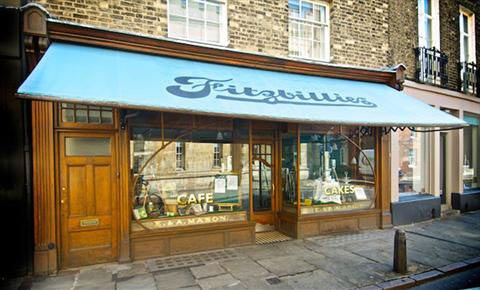
5. Creation of the middle way.
In general terms Cambridge, in this particular much like Oxford and utterly unlike Providence, lacks much in the culinary middle. Both towns are inhabited by the usual clutch of celebrated establishments that charge eye watering amounts now found in every small English city; the promiscuous proliferation of cheap and cheerful places inevitably infesting college towns for the kids to escape their cafeterias; and nearly nothing in between.
This state of affairs may seem a surprise but its persistence has proven palpable. Thanks to a number of those addicted to the restaurant trade in Cambridge, however, little rather than nothing now finally bridges the void between the unaffordable and unmemorable. By far the best of this new breed is Pint Shop, which caused a considerable stir as the first new public house in Cambridge since 1999 when it opened a couple of years ago. Notwithstanding its misdirectional name, it is not a place dedicated only to those who want to guzzle lots of beer, although it is a place happy enough to indulge its habitués in that particular pastime too.
Pint Shop’s website includes its statement of “vision,” a statement at times grammatically infelicitous but based on our visits entirely accurate in both intent and execution. It is, they hope, a
“place where you feel equally at home having a few beers, a light lunch or a full blown feast. A place where people from all walks of life rub shoulders with each other.”
6. A most welcome statute; a most welcome beer.
This may sound generic but is not, derived instead from the spirit of the British Beer Act of 1830, legislation allowing “anyone that [sic] paid a small fee to brew beer and sell it in their [sic] home.” Out of the act, which had been designed “to reduce drunkenness, improve the health of the nation, and encourage free trade,” arose the Beer Houses.
The target of the Beer Act had been the working class consumption of gin, a drink cheaper and more deleterious than beer, at least before the act itself. As usual the initiative would entail unintended consequences, among them a proliferation of the convivial Beer House itself, precursor to the public house that would take its turn to inflame the ire of humorless Reform.
Pint Shop has had the wisdom not to brew its own beer, a mistake that has ruined many a publican: As running for office differs from ruling, so the skill to brew differs from the skill to pump. The proprietors of the place scour the British Isles for the product of craft brewing, a task Sisyphean enough only a short span ago. They are good hunters.
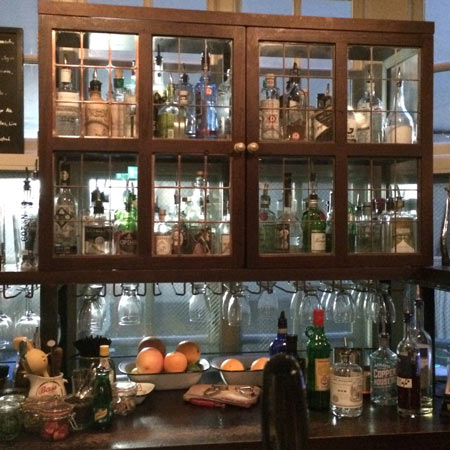
Among their quarry, for example; Fusilier, an ale styled “bitter,” the term itself not only no longer ubiquitous but even fallen entirely from grace until now, from the Hop Stuff brewery in Woolwich, the old arsenal town east of London. Fusilier can boast the precise taste of the traditional cask bitters the industrial brewing syndicates sought to stamp out starting in the seventies. They nearly succeeded but thanks to Hop Stuff and its brothers in arms failed to destroy British ale as we now again know it. There can be no better endorsement of a brewer or its beer.
7. The lay of the land, including, configuration of the essential pumps.
Pint Shop is no ‘gastropub,’ no magpie’s chick of a restaurant plunked incongruously into an old boozer. Instead the place evokes the era of the Beer House without descending into replicosity, while showcasing clean contemporary lines without succumbing to steampunk cliché. The absence of too much aesthetic tension (the little that inhabits the place is good) testifies to the skill of Macaulay Sinclair, the design team the proprietors chose to reinvent the building Pevsner considers an “unusually ambitious house of 1830.”
Despite their minimalist tendency the rooms at Pint Shop are welcoming, the result in no small part of the staff. Their understated warmth complements the tone of the interior, and if that sounds strange it also ought to sound compelling. It is as if an overlay of reimagined Regency fittings cohabits an industrial space. Utilitarian black lamps powered through languid loops of matching wire give the space an airy aspect.
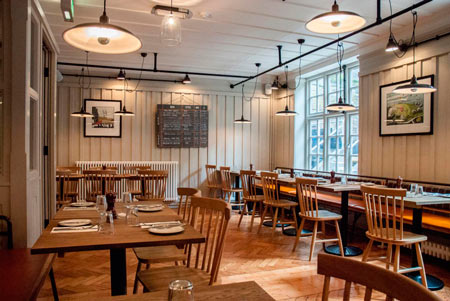
Cream-colored panels of vertical clapboard and wry historic references help. In the big main bar, puffy black cask blankets splay across a wall on hooks, a postmodern evocation of the imperial carpets fashioned from animal skins.
Wooden benches braced with backs of sturdy steel line the walls, but they seem less uncomfortable benches than most. Tables scattered artfully across the floor share the same robust species of wood as those benches, while seating alternates between interpretations of schoolhouse chairs and stools that evoke salvage from the office of a nineteenth century architect.
The smaller, much smaller back bar hidden behind a curving screen of small paned glass is even better, like the kind of cramped and cozy closet off the kitchen that counterintuitively attracts the biggest crowd during a dinner party. The six cask engines operate in isolation back here, a secret stash segregated from the ten taps and ranks of bottles to the front and back of the main bar.
Bars are always best in places like this but the dining room at Pint Shop is not at all bad. It shares the same broad planking as the big bar painted a warm dark grey; trails of tartan cushion add another degree of comfort to the same utility benches installed in the bar. Modern descendants of spindly eighteenth century spindleback chairs lend an air of higher order if not quite formality, while squat tabletop candles, something akin to votives abusing steroids, cast everyone and thing in flattering light.
8. Light lunches and full-blown feasts.
Pint Shop hews to its vision. You can buy biltong, from the Limpopo Butchers in London (the name a welcome postimperial flourish), fries with curry sauce and pickles worthy of Brooklyn itself. Apropos of the borough, bartenders know their wares--obscure gins destined for crafty cocktails are a feature of the house--and all the people at Pint Shop know their beer.
You cannot always only drink in a bar so the sausage rolls sing. The Scotch Egg has a runny yolk, which must rank as some sort of culinary sleight of hand. It is encased in the same pliant sausage as the roll, with a crisp and greaseless coating. Pork belly sandwiches can prove problematical (all that oleaginous slurry) but not here. They roast the belly overnight, so long and slow that its fat leaches away leaving a residue of tender meat that looks like loin and tastes like an essence of pork.
So much for the casual snack; what about the higher ambition, the “full-blown feast?” This is a British restaurant, not just a restaurant located in Britain but one dedicated to British food. It also, however, is a dedicated follower of fashion (prior reference: those pickles on the bar) so, a telltale sign of the times, nods to the American south infiltrate the menu in the form of deep fried back ribs, southern fried rabbit and the corn fritter that makes an appearance with a British classic, potted crab.
That kind of classic graced with a most modern attention to detail predominates at Pint Shop. Sometimes there is Chicken Escoffier, a ‘sautez.’ It sounds French but is not: That grandest of chefs created the dish during his long tenure at the Savoy in London. The kitchen at Pint Shop likes to cook over coals, and actually turns its beef and other meat on a spit in the manner of Hannah Glasse and Maria Rundell rather than ‘roasting’ it in an oven (that is, baking it) it in the manner of, well, everybody else today.
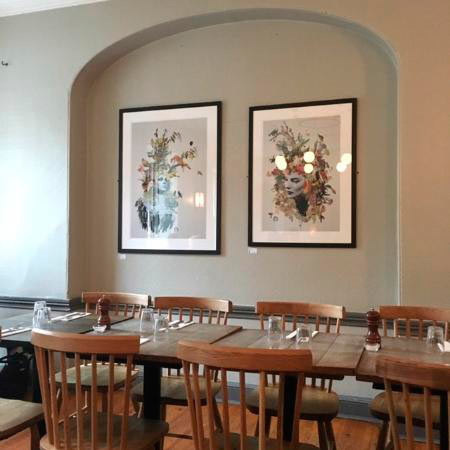
Vegetarians can happily coexist with the most atavistic carnivore at Pint Shop and they do. Cooked vegetarian dishes are neither insipid nor heavy but rather composed with care from anything, and only things, seasonal. A salad of green, red and yellow heirloom tomatoes also shone. If the texture is not quite up to this year’s astounding crop in New England, the flavor is big and accompaniments good; dense rye bread scattershot with kernels of the grain and a mildly pungent pot cheese laced with an array of seasonal herbs.
The best description is this last description, of a steak and pickled walnut pie studded with the smallest English onions. The steak is good, its gravy is good, the pastry--a proper coffin, not just the afterthought of a lid--is good and the inclusion of the walnuts is sublime. Once again the attention to detail was impressive, in the scallion mashed potato, the clapshot and then the unexpected braised cabbage and roast potatoes our personable waiter brought homestyle for the table.
The wine list is short, interesting and reasonable. Good selections are available by the glass, including a subversive Cahors that eloped with the pie. Prices? Nowhere near what you would expect for this level of service and quality of food.
Pint Shop
10 Peas Hill
Cambridge CB2 3PN

